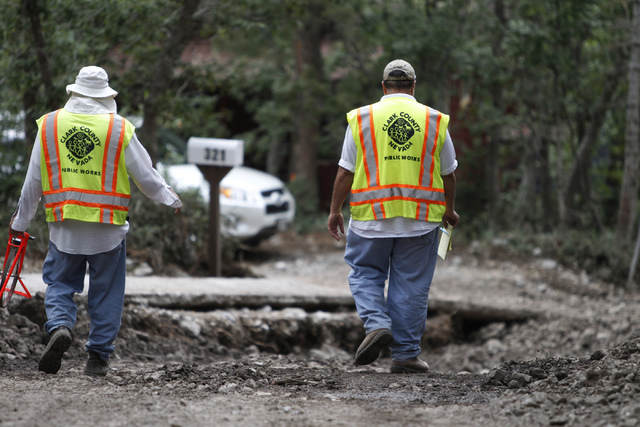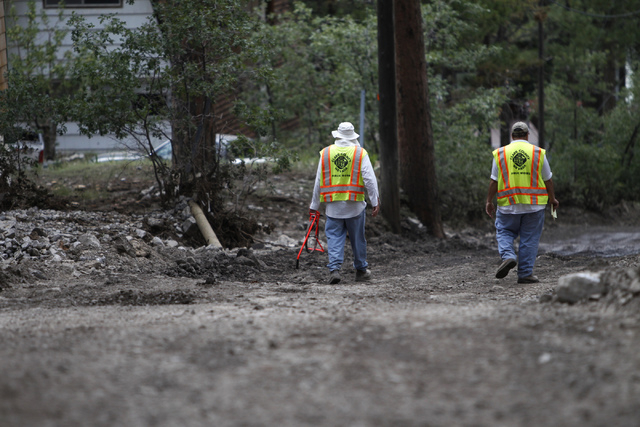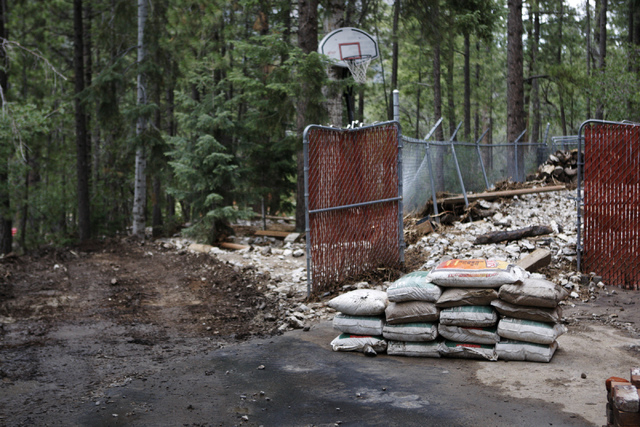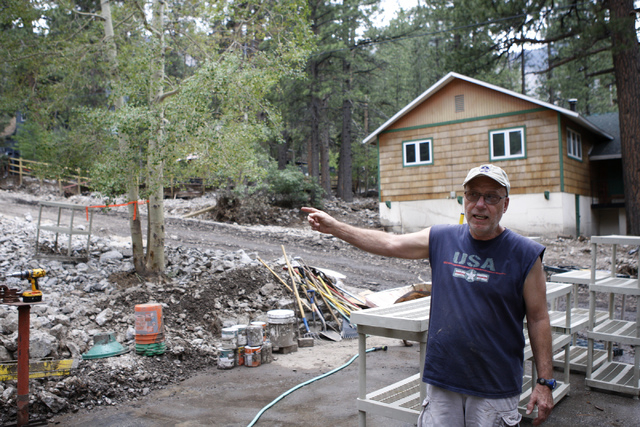Berm could have shielded Rainbow from flooding















The soaked Rainbow community on Mount Charleston could have had more protection from Monday’s flash flood that destroyed roads, battered houses and blanketed yards with rocks and mud.
In the months before the flood, Clark County and federal officials were unsuccessful in reaching an agreement to put an earthen berm near the community to carry floodwater down the mountainside.
U.S. Army Corps of Engineers officials said Wednesday they were prepared to start the project on June 1 and have the 1,700-foot-long berm complete before the July monsoon season hit.
But county officials didn’t sign off on the agreement because of its requirement that the county assume legal liability for the structure. The county was willing to handle required maintenance and repairs the berm for its lifespan of about seven to 10 years. The plan also would have required the county to remove the structure and restore vegetation.
Officials started looking for flood prevention measures after the Carpenter 1 Fire destroyed vegetation and trees uphill from the Rainbow subdivision, making it more prone to flooding.
Mount Charleston residents are unimpressed with the county’s unwillingness to move forward with the agreement.
“What about the liability up there right now?” Rainbow subdivision resident Becky Grismanauskas said. “You would not believe this neighborhood looks like a war zone.”
Her husband, Duffy Grismanauskas, estimates that at least 20 homes in the mountain community were damaged in some way, from wiped-out landscaping to serious foundation and structural damage. The flooding also closed the access road for a couple of days and forced residents to boil water as a precaution.
“It’s just disgusting what the county did to us,” he said.
District Attorney Steven Wolfson notified federal officials in a June 2 letter that the requirements of the agreement weren’t agreeable with county officials.
County Commissioner Larry Brown, whose district encompasses Mount Charleston, said the area needs protection from floods, but said he agreed with the county’s legal counsel.
“The risk is too great, because it has the potential to cost taxpayers millions of dollars in assuming that contractual obligation, and we just can’t do that.”
Brown said the county is willing to be a partner for maintenance of the project, including repairing any damage from future floods. However, he noted the county has had no input into the design of the temporary structure.
“At the end of the day, we were simply asked to accept it,” he said.
Wolfson’s letter left the door open to further negotiations with the Army Corps of Engineers, and Brown stressed that the county hopes the parties can reach a compromise.
The challenges won’t end with this flood cleanup. The U.S. Forest Service estimates it will take five to seven years for vegetation to grow back after the Carpenter 1 Fire that charred nearly 28,000 acres of land from July 1, 2013, until its containment in mid-August.
Flooding in September 2013 that damaged the area demonstrated the region’s risk for future floods.
The community attracts residents ranging from retirees to working professionals who want views of mountains at an elevation of about 7,000 feet.
It’s uncertain how much the flood control structure would have protected the Rainbow community, said Anne Hutton, chief of the Corps of Engineers’ Emergency Management Office.
“If you look at the map, and if you looked at where the project was proposed and where the damage is, it would be hard for anyone to assume there wouldn’t have been lesser affects of the storm,” Hutton said.
Language in the contract that requires a sponsor to take on those duties falls in line with federal regulations, said Jay Field, a spokesman for the agency that designs and builds infrastructure projects. The agency’s projects typically require a local sponsor to take them over after they are built, he said.
Corps engineers visited the site in March after state officials sought help.
Randy Swick, area manager for the Spring Mountains National Recreation Area, said the Forest Service had drafted a special use permit for the project and was ready to aid the corps on June 1.
Meanwhile, residents like Ron Erskine are still digging out from the storm. His lawn is buried by rocks, and he had three feet of mud in his garage.
“I’ve got a house that you’re scared to live in, that you can’t sell, that you can’t rent. What are you going to do?”
Added Duffy Grismanauskas: “It’s heartbreaking to a point where we’re devastated and our spirit is broken.”
Contact Ben Botkin at bbotkin@reviewjournal.com or 702-387-2904. Find him on Twitter: @BenBotkin1.













